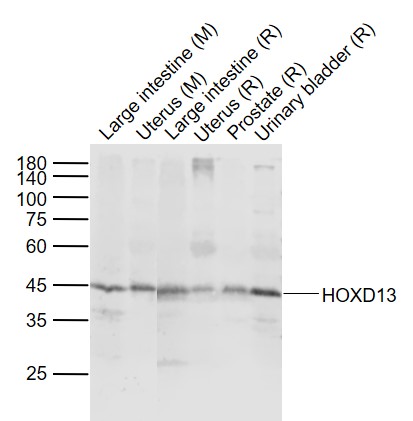
Rabbit Anti-HOXD13 antibody
HOXD13; BDE; BDSD; Homeo box 4I; Homeo box D13; Homeo box protein Hox D13; Homeo box protein HoxD13; Homeobox 4I; Homeobox D13; Homeobox protein Hox D13; Homeobox protein Hox-D13; Homeobox protein HoxD13; Homeobox4I; HomeoboxD13; Hox 4I; HOX D13; Hox-4.8;
View History [Clear]
Details
Product Name HOXD13 Chinese Name 同源盒蛋白D13抗体 Alias HOXD13; BDE; BDSD; Homeo box 4I; Homeo box D13; Homeo box protein Hox D13; Homeo box protein HoxD13; Homeobox 4I; Homeobox D13; Homeobox protein Hox D13; Homeobox protein Hox-D13; Homeobox protein HoxD13; Homeobox4I; HomeoboxD13; Hox 4I; HOX D13; Hox-4.8; Hox4I; HOXD 13; HoxD13; SPD; HXD13_HUMAN. Research Area Developmental biology transcriptional regulatory factor Cell differentiation Epigenetics Immunogen Species Rabbit Clonality Polyclonal React Species Mouse, Rat, (predicted: Human, Pig, Cow, Rabbit, Sheep, ) Applications WB=1:500-2000 ELISA=1:5000-10000
not yet tested in other applications.
optimal dilutions/concentrations should be determined by the end user.Theoretical molecular weight 36kDa Cellular localization The nucleus Form Liquid Concentration 1mg/ml immunogen KLH conjugated synthetic peptide derived from human HOXD13: 251-343/343 Lsotype IgG Purification affinity purified by Protein A Buffer Solution 0.01M TBS(pH7.4) with 1% BSA, 0.03% Proclin300 and 50% Glycerol. Storage Shipped at 4℃. Store at -20 °C for one year. Avoid repeated freeze/thaw cycles. Attention This product as supplied is intended for research use only, not for use in human, therapeutic or diagnostic applications. PubMed PubMed Product Detail The Hox proteins play a role in development and cellular differentiation by regulating downstream target genes. Specifically, the Hox proteins direct DNA-protein and protein-protein interactions that assist in determining the morphologic features associated with the anterior-posterior body axis. HoxD13 is a sequence-specific transcription factor that provides cells with specific positional identities on the anterior-posterior axis of developing mammals. Defects in HoxD13 are the cause of synpolydactyly (SPD). SPD is a limb malformation that shows a characteristic manifestation in both hands and feet. This condition is inherited as an autosomal dominant trait with reduced penetrance. Defects in HoxD13 are also the cause of brachydactyly type D and type E.
Function:
This gene belongs to the homeobox family of genes. The homeobox genes encode a highly conserved family of transcription factors that play an important role in morphogenesis in all multicellular organisms. Mammals possess four similar homeobox gene clusters, HOXA, HOXB, HOXC and HOXD, located on different chromosomes, consisting of 9 to 11 genes arranged in tandem. This gene is one of several homeobox HOXD genes located in a cluster on chromosome 2. Deletions that remove the entire HOXD gene cluster or the 5' end of this cluster have been associated with severe limb and genital abnormalities. Mutations in this particular gene cause synpolydactyly.
Subcellular Location:
Nuclear
DISEASE:
Defects in HOXD13 are the cause of synpolydactyly 1 (SPD1) [MIM:186000]; also known as syndactyly type 2 (SDTY2). SPD1 is a limb malformation that shows a characteristic manifestation in both hands and feet. This condition is inherited as an autosomal dominant trait with reduced penetrance.
Defects in HOXD13 are the cause of brachydactyly type D (BDD) [MIM:113200]. BDD is characterized by short and broad terminal phalanges of the thumbs and big toes. Inheritance is autosomal dominant.
Defects in HOXD13 are the cause of syndactyly type 5 (SDTY5) [MIM:186300]; also known as syndactyly with metacarpal and metatarsal fusion. The metacarpals and metatarsals most commonly fused are the 4th and 5th or the 3rd and 4th. Soft tissue syndactyly usually affects the 3rd and 4th fingers and the 2nd and 3rd toes. Inheritance is autosomal dominant.
Defects in HOXD13 are the cause of brachydactyly-syndactyly syndrome (BDSD) [MIM:610713]. Most of affected indi iduals exhibit generalized shortening of the hands and feet, broad and short distal phalanges of the thumbs, and cutaneous syndactyly of toes 2 and 3. The limb phenotypes obser ed in this syndrome o erlap those of brachydactyly types A4, D, E and syndactyly type 1.
Defects in HOXD13 are the cause of brachydactyly type E (BDE1) [MIM:113300]. BDE is characterized by shortening of the fingers mainly in the metacarpals and metatarsals. Inheritance is autosomal dominant.
Defects in HOXD13 are a cause of ACTERL association ( ACTERL) [MIM:192350]; which includes also ATER association. ACTERL is an acronym for ertebral anomalies, anal atresia, congenital cardiac disease, tracheoesophageal fistula, renal anomalies, radial dysplasia, and other limb defects.
Similarity:
Belongs to the Abd-B homeobox family.
Contains 1 homeobox DNA-binding domain.
SWISS:
P35453
Gene ID:
3239
Database links:Entrez Gene: 3239 Human
Entrez Gene: 15433 Mouse
Omim: 142989 Human
SwissProt: P35453 Human
SwissProt: P70217 Mouse
Unigene: 152414 Human
Unigene: 57227 Mouse
Unigene: 79274 Rat
Product Picture
Lane 1: Large intestine (Mouse) Tissue Lysate at 40 ug
Lane 2: Uterus (Mouse) Tissue Lysate at 40 ug
Lane 3: Large intestine (Rat) Tissue Lysate at 40 ug
Lane 4: Uterus (Rat) Tissue Lysate at 40 ug
Lane 5: Prostate (Rat) Tissue Lysate at 40 ug
Lane 6: Urinary bladder (Rat) Tissue Lysate at 40 ug
Primary: Anti-HOXD13 (SL12197R) at 1/1000 dilution
Secondary: IRDye800CW Goat Anti-Rabbit IgG at 1/20000 dilution
Predicted band size: 36 kD
Observed band size: 45 kD
Bought notes(bought amounts latest0)
No one bought this product
User Comment(Total0User Comment Num)
- No comment



 +86 571 56623320
+86 571 56623320
 +86 18668110335
+86 18668110335

